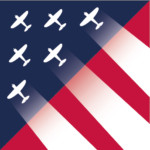WWII Vets Tell Their Stories; American Flag is Donated
A group of World War II veterans told their stories to Museum visitors on Saturday in an event sponsored by the Southern Colorado Honor Flight. One vet donated what has become a rarity — a 48-star American flag.
Ted Langowski, 97, who served as a stateside medic during World War II, donated the flag. The flag has borne 50 stars since 1959, when Alaska and Hawaii were admitted to the union. Before that, beginning in 1912, it was a 48-star flag.
In about 1959, Langowski was helping Boy Scouts dispose of 48-star flags at the Scouts’ Camp Alexander, near Lake George, Colorado. He saved the one he presented to Museum CEO and President Bill Klaers on Saturday.
The vets told their stories as they sat at tables by the open hangar doors of the Kaija Raven Shook Pavilion. One of the Museum’s two Tigercats stood behind them, parked just outside. Museum visitors could easily talk to individual vets. More than 200 people visited the Museum on that day.
One of the vets, Cole Griego, a U.S. Navy corpsman with the Marines during the battle for Iwo Jima, had his own flag story. He stood just feet away as Marines raised the American flag atop Mount Suribachi on Feb. 23, 1945. The moment was captured in a photograph that has become iconic. Griego said the moment was wonderful, but he was deeply affected by the things he saw. He called it “hell in a hat.”
J.J. Inman was a P-51 pilot with the Flying Tigers in China in 1944 and 1945. He flew a harrowing mission in which his fuel ran out moments after he landed back at his base.
Wayne Daniels was a B-17 pilot. He was shot down on his fifth mission. Four of his crewmen were killed. He was a POW until the end of the war.
Bill Roche was a B-17 waist gunner. He was shot down twice, once in France and again in Poland. He spent six months in the custody of the Soviet Union..

Photo credit: Wayne Daniels
<!– /* Font Definitions */ @font-face {font-family:”Cambria Math”; panose-1:2 4 5 3 5 4 6 3 2 4; mso-font-charset:0; mso-generic-font-family:roman; mso-font-pitch:variable; mso-font-signature:-536869121 1107305727 33554432 0 415 0;} @font-face {font-family:Calibri; panose-1:2 15 5 2 2 2 4 3 2 4; mso-font-charset:0; mso-generic-font-family:swiss; mso-font-pitch:variable; mso-font-signature:-469750017 -1073732485 9 0 511 0;} /* Style Definitions */ p.MsoNormal, li.MsoNormal, div.MsoNormal {mso-style-unhide:no; mso-style-qformat:yes; mso-style-parent:””; margin:0in; mso-pagination:widow-orphan; font-size:11.0pt; font-family:”Calibri”,sans-serif; mso-fareast-font-family:Calibri; mso-fareast-theme-font:minor-latin;} .MsoChpDefault {mso-style-type:export-only; mso-default-props:yes; font-family:”Calibri”,sans-serif; mso-ascii-font-family:Calibri; mso-ascii-theme-font:minor-latin; mso-fareast-font-family:Calibri; mso-fareast-theme-font:minor-latin; mso-hansi-font-family:Calibri; mso-hansi-theme-font:minor-latin; mso-bidi-font-family:”Times New Roman”; mso-bidi-theme-font:minor-bidi;} @page WordSection1 {size:8.5in 11.0in; margin:1.0in 1.0in 1.0in 1.0in; mso-header-margin:.5in; mso-footer-margin:.5in; mso-paper-source:0;} div.WordSection1 {page:WordSection1;} –>
Wayne Daniels

